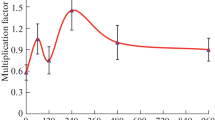Abstract
Air-dry tomato seeds were treated with an ethylene imine dilution series. Most sterile M1-plants can be detected morphologically at an early stage. Few of the morphological “deviants” proved to be fertile. Both with regard to M1 - and to M2 - growing space the highest concentration leaving fertiles (0.25%) was the most efficient. At this dose the rate of mutation which can be scored on young M2-plants, reached a value of 1.04 per M2-family. A small shortage of M2-families with 1 mutation is suggested by different tests. This may be due to penetrance heterogeneity. The spectrum of chlorophyll mutations changes with the EI concentration, a significantly smaller proportion of chlorodefectios (albinas, etc.) being found at higher concentrations.
Similar content being viewed by others
References
Blixt, S., Ehrenberg, L., and Gelin, O., 1960. Quantitative studies of induced mutations in peas. III. Mutagenic effect of ethylene imine. Agri Hort. Gen. 18: 109–123.
Clayberg, C. D., Butler, L., Rick, C. M., and Young, P. A., 1960. Second list of known genes in the tomato. J. Heredity 51: 167–174.
Ehrenberg, L., Gustafsson, A., and Lundqvist, U., 1959. The mutagenic effects of ionizing radiations and reactive ethylene derivatives in barley. Hereditas 45: 351–368.
Ehrenberg, L., Gustafsson, A., and Lundqvist, U., 1961. Viable mutants induced in barley by ionizing radiations and chemical mutagens. Hereditas 47: 243–282.
Ehrenberg, L., Lundqvist, U., and Ström, G., 1958. The mutagenic action of ethylene imine in barley. Hereditas 44: 330–336.
Gaul, H., 1957. Die verschiedenen Bezugssysteme der Mutationshäufigkeit bei Pflanzen, angewendet auf Dosis-Effectkurven. Zeitschrift Pflanzenzüchtung 38: 63–76.
Heslot, H., Ferrary, R., Lévy, R., et Monard, C., 1959. Recherches sur les substances mutagènes: (halogéno-2-éthyle) amines, dérivés oxygénés du sulfure de bis (chloro-2-éthyle), esters sulfoniques et sulfuriques. C. R. Acad. Sci. (Paris) 248: 729–732.
Heslot, H., Ferrary, R., Lévy, R., et Monard, C., 1961. Induction de mutations chez l'orge: efficacité relative des rayons gamma, du sulfate d'éthyle, du méthane sulfonate et quelques autres substances. In: Effects of ionizing radiations on seeds. (Proc. Symp. Karlsruhe, 1960, IAEA, Vienna): 243–249.
Kulik, M. J., 1961. Experimental mutation in tomatoes (In Russian). Radiobiologija 1: 624–626. (Pl. Br. Abstr. 32: Ref. 4028).
Lamprecht, H., 1960. Uber Blattfarben von Phanerogamen. Agri Hort. Gen. 18: 135–168.
McKelvey, A. D., 1962. Differential response to mutagens in Arabidopsis thaliana. Nature 195: 409–410.
Stubbe, H., 1960. Mutanten der Kulturtomate Lycopersicon esculentum Miller. III. Die Kulturpflanze 7: 82–112.
Verkerk, K., 1959. Neutronic mutations in tomatoes. Euphytica 8: 216–222.
Author information
Authors and Affiliations
Rights and permissions
About this article
Cite this article
Hildering, G.J. The mutagenic effect of ethylene imine (EI) on the tomato. Euphytica 12, 113–119 (1963). https://doi.org/10.1007/BF00033602
Received:
Issue Date:
DOI: https://doi.org/10.1007/BF00033602




